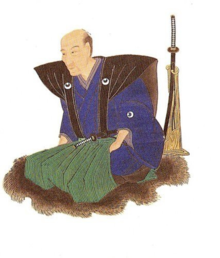Chiba Shūsaku
Chiba Shūsaku Narimasa ( Japanese 千葉 周 作 成 政 , * 1793 either in Kurihara (now part of Kesennuma ), in Miyagi Prefecture or in Rikuzentakata , Iwate Prefecture ; † January 17, 1856 ) was a Japanese samurai and the founder of the Koryū ( 古 流 ) Fencing school, Hokushin Ittō-ryū Hyōhō ( 北辰 一刀 流 兵法 ) and one of the last masters who was dubbed Kensei (sword saint). Shūsaku was his nickname used during his lifetime; his go was Narimasa ( 成 政 ). His full name, which he used during his lifetime and with which he signed the scrolls he exhibited, was Chiba Shūsaku Taira no Narimasa .
Family background
Chiba Shūsaku was the son of the samurai Chiba Chūzaemon Naritane ( 千葉 忠 左衛 門 成 胤 , family name – first name – real name), who originally came from Miyagi Prefecture . He was born as the second son of his family in Kesen. His father Chūzaemon learned the art of sword under Chiba Narikatsu called Kōemon ( 千葉 幸 右衛門 成 勝 ), the founder of the sword art direction Hokushin Musō-ryū. There is some confusion about Chiba Shūsaku's origins since his father Chūzaemon and his family moved to Mito. His father was adopted by Chiba Kōemon because of his ability with the sword (this was around 1800). Chiba Shūsaku originally learned the Hokushin Musō-ryū, first from his father and then directly from his grandfather Chiba Kōemon Narikatsu. At this time he changed his name to Chiba Shūsaku or Taira no Narimasa.
In 1809 his father Chiba Chūzaemon moved again with his family, this time to Matsudo, near Edo . At this time Chiba Shūsaku learned the Ittō-ryū from Asari Yoshinobu Matashichirō and Nakanishi Chūbei Tanemasa. He married Asari's daughter, took his family name and ran the Asari-Dōjō together with his father-in-law. After falling out with his father-in-law, he divorced, left the Asari family and changed his name back. When he left the Asari family, he began his Musha-shugyō (warrior pilgrimage), visited numerous Dōjō and dueled with a number of famous masters from the most famous schools in the country. These included the Shintō Munen-ryū, Jikishinkage-ryū, Maniwa Nen-ryū, as well as numerous Ittō-ryū lines and many others. It is also said that he should not have lost a single duel in his life.
Hokushin Ittō-ryū Hyōhō
After Chiba Shūsaku learned numerous other schools, he founded his own school in 1821, the Hokushin Ittō-ryū Hyōhō. The name is a combination of the Hokushin Musō-ryū and the Ittō-ryū lines that he mastered.
In some areas, the Hokushin Ittō-ryū is a simplified form of the Ittō-ryū lines, but focuses on the essentials in technology. What is certain is that the teaching methods of Chiba Shūsaku were more understandable than those of other schools. In the Bakumatsu period there was a saying, "If it takes a person six years to master a ryūha, it will only take half the time in the Hokushin Ittō-ryū". The easy-to-understand teaching methods ensured that the school grew rapidly in popularity. The school's curriculum mainly contains Kenjutsu , Battōjutsu , Naginatajutsu and Jiu Jitsu . Chiba Shūsaku founded the Edo-Genbukan, which together with the Chiba-Dōjō of his brother Chiba Sadakichi Masamichi became one of the largest and most famous dojōs in Japan. In the middle of the Taishō period , the line of the Edo-Genbukan disappeared shortly after the Dōjō was destroyed in the great Kanto earthquake in 1923 . The Chiba-Dōjō was also destroyed in the earthquake, but this line, unlike that of the Edo-Genbukan, still exists today and is now led by Ōtsuka Yōichirō Masanori as the 6th head ( Sōke ).
Web links
- Official website of the Hokushin Ittō-ryū Hyōhō (Hombu-Dōjō Japan)
- Official website of the Hokushin Ittō-ryū Hyōhō (Hombu-Dōjō Europe)
- Official website of the Hokushin Ittō-ryū Hyōhō (Shibu Switzerland)
- Official website of the Hokushin Ittō-ryū Hyōhō (Dōkōkai Bonn)
- Family Tree of the Hokushin Ittō-ryū Chiba Family (Japanese)
Individual evidence
| personal data | |
|---|---|
| SURNAME | Chiba, Shūsaku |
| ALTERNATIVE NAMES | 千葉 周 作 (Japanese); Chiba Narimasa (real name); 千 葉成政 (Japanese, real name); Chiba Shūsaku Narimasa; 千葉 周 作 成 政 (Japanese); Chiba Shūsaku Taira no Narimasa (full name) |
| BRIEF DESCRIPTION | japanese samurai |
| DATE OF BIRTH | 1793 |
| PLACE OF BIRTH | uncertain: Kurihara , today: part of Kesennuma , Miyagi Prefecture or Rikuzentakata , Iwate Prefecture |
| DATE OF DEATH | January 17, 1856 |
